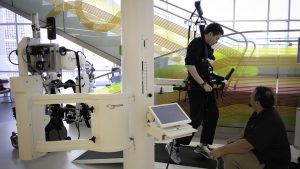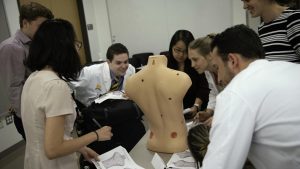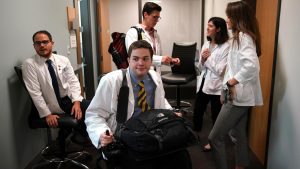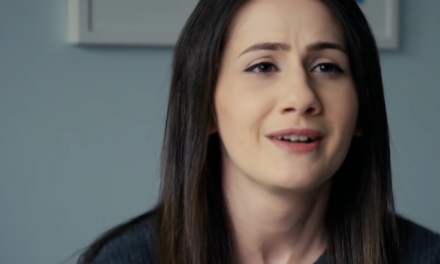Like any mother who suddenly finds herself in a hospital waiting room, Helen Connolly was uneasy.
It was Feb. 28, 2007, and her younger son, Chris, had been taken to the Northwestern Memorial Hospital emergency room — there had been an accident during his Wednesday water polo practice.
Chris, who had turned 15 three days earlier, was a freshman on the St. Ignatius College Prep team, following in the footsteps of his brother, Dennis, nine years his senior. He and Helen were close — he was her later-in-life child, a sweet, still-gawky kid who shared her curiosity and a measure of her intense drive.
She had dealt with the practical details: Her husband, also Dennis, was with her, and she’d let Chris’ brother know. It doesn’t sound like a big deal, she told him. But just in case.
Now, in the hospital, she was just managing her nerves.
Time dragged, until finally, there was news: “The nurse came out, a male nurse,” Helen says, “and said, ‘I’m sorry to tell you, but your son is quadriplegic.’”
Events seemed to blur — the family was taken to Chris, and found him lying on a hospital bed, unable to move. He was terrified, frantic, Helen remembers. “He was saying, ‘Mom, what’s happening to me? What’s happening to me?’” The horrible part was, she didn’t know. “There was this sense of disbelief,” she says, “like, you have got to be kidding me. I sent a healthy young man to school this morning.”
Eleven years later, Chris is in an exam room at the University of Michigan Medical School. A doctor, with a clipboard, watches from the corner as Chris approaches a patient on the table. “Please lift your left arm,” Chris says, peering at the skin along her outstretched limb a little self-consciously. It’s a routine dermatological exam — or a reasonable facsimile of one — except there’s nothing routine about it.
Chris is still a quadriplegic, having regained limited motion in his arms and legs only through unrelenting physical therapy. He is also a successful second-year medical student who navigated an undergrad education and master’s program in biology at Stanford and the rigors of applying to medical school to get here. And that’s just the academics. He eases his wheelchair back and smiles at the patient. “Everything looks good.”
The dramatic change in roles Chris Connolly has experienced, from critically injured patient to budding doctor, represents the convergence of a wide array of details: the school that helped lift him to extraordinary academic heights; the physical therapist who told him to walk; the teacher who questioned whether he could keep up; the engineer father who taught him to tinker and invent; the brother who didn’t give him an inch; the mother whose determination never allowed them to fall back.
It also represents the growing movement to rethink rules that have long prevented most people with disabilities from entering the medical profession. Disability experts estimate that he is one of only four or five medical students in the nation with his level of physical disability. The societal shift he represents aims not only to reinvent medical school standards and correct a profession that has largely exempted itself from inclusion of the disabled, but to change the way all of us think about doctors.
The thing is, once you meet Chris Connolly, the question quickly becomes not how could he be a doctor, but why wouldn’t he be a great one?
Life at medical school is never easy, but as with most things Chris does, he must navigate an additional degree of difficulty. He does this with the help of his family. After class, he zips down the sidewalk to a spot where his dad can easily pick him up in the wheelchair accessible van the family drives. Helen and Dennis are now retired, and living with Chris in graduate student housing at Michigan.
“We’re here,” Dennis says, “just to level the playing field for him.” It’s an undertaking that hums with near-military discipline: Because of the challenges of something as routine as getting out of the house in the mornings, Chris must be up at 4 a.m. to make it to an 8 a.m. class. “I can do most things myself,” he says. “It just takes me a lot longer.”
He’s relentless when it comes to studying, attending lectures, then re-watching them online twice to make sure he gets all he can from each one. Physical therapy is usually accomplished by using electronic stimulation to move his muscles while he’s busy working. The walls of the apartment are decorated with motivational quotes, words (“Grit,” “Believe”) and photographs, including one of a triumphant Muhammad Ali. His mom makes sure medical supplies are ordered, appointments get made, laundry gets done.
“Do you need anything?” she asks before leaving the house. She has been his caregiver since the accident, and they’ve been roommates since he started college at Stanford in 2011. “We’ve actually been attached at the hip for 11 years,” Helen says, “and I make no apologies for that, because nobody takes care of him like we do.”
On that terrible February day when Chris’ life was transformed, his family — perhaps his mother most of all — was transformed too. Dennis and Helen had pursued careers — his as an engineer in private practice and as acting commissioner of the city’s Department of Sewers, hers as a special education teacher who also taught herself computer programming and day trading. They’d helped care for chronically ill relatives and raised their boys as good parochial-school students and achievers.
“My mom and dad raised us,” Chris says, “with the idea that it never hurts to try to do a little more. And I think that’s ingrained in my brother and me.”
Connolly routinely watches lectures as many as three times.
With Chris in high school, the family had planned to downsize from their home in Beverly to a place near his school, and Helen hoped to retire. She wasn’t the frivolous type, but she had been joking about getting a little red convertible.
Instead, she spent more than three months sleeping in a chair beside Chris’ hospital bed at the Rehabilitation Institute of Chicago. The family watched roommates with lesser injuries regain motion or start to walk again.
But for Chris, “there was not a lot of progress,” says his brother. “My mom was trying to keep us all moving forward. But we were all depressed, him especially. I remember looking at him, and he just looked right through you, it was the thousand-yard stare. That was really scary, and he was like that for a while.”
Yet, even early on, there was a sense of the road back. While other patients watched TV in the hospital, Chris listened to motivational tapes. “My guilty pleasure is Zig Ziglar,” he says. Some people turn their kids on to their favorite music — Helen gave Dennis and Chris an intro to 1970s motivational speaker Ziglar, whose positivity talks have the addictive cadence of upbeat televangelism.
“He’s a very funny guy,” Chris says. “All of his seminars, too, have the best names, like ‘Born to Win.’ I mean, that could be a rap album. Kanye could come out with that right now and go to No. 1.”
Progress came in hard-fought increments: A trip to Johns Hopkins University’s Kennedy Krieger Institute, a renowned center for treatment of spinal cord injuries, put renewed focus on Chris’ physical potential. He had discovered that, gradually, some function was returning to his limbs.
“I was eating chicken nuggets,” he says, “because they taste great, and realized that they were really burning my fingers. So that’s how I realized I had some sensation returning to my hands, and now I have pretty good sensation in three fingers on each hand. So I highly recommend that method, eating chicken nuggets.”
Chris Connolly and Walter Guminiak, his physical therapist at the Shirley Ryan AbilityLab, speak on Aug. 23, 2018, about how far Connolly has come since he began therapy. Connolly is quadriplegic and one of few disabled students to have been admitted to medical school.
He also found a mentor and friend in physical therapist Walter Guminiak, who bonded with the Connolly family when the two started working together at RIC not long after Chris’ accident. They have worked together, off and on, ever since. “One day,” says Helen, “Walter told Chris, ‘OK, Boss, just start walking.’” Amazingly, Chris’ legs started to move.
“I think one of the most valuable experiences I gained,” Chris says, “was that it’s really great if you offer the best care you can give, but there’s a lot to be said for making people feel normal, as well.”
At times, the battle against paralysis seemed more rewarding than the struggle to simply resume normal life. When he returned to St. Ignatius to start his sophomore year in fall 2007, Chris’ brother says, school administrators “were like deer in headlights. They had done nothing to prepare for him coming back.”
Chris and his family felt that the environment was, at best, awkward, at other times hostile. “There were some classrooms where the kids would literally all sit on the other side of the room,” his brother says, “and the teacher didn’t do anything about it. It felt like we were fighting for everything.”
“There was a dark moment where I think he wanted to drop out,” says his dad.
The circumstances surrounding Chris’ accident didn’t help. The Connollys sued St. Ignatius for negligence in 2009, alleging that Chris’ accident was part of a hazing incident encouraged by water polo coaches. Neither the family nor the school will discuss the details of the case, which was settled.
John Chandler, Ignatius vice president, says the family’s sense of hurt is understandable, but “I do know that St. Ignatius would never do anything to deliberately harm a young person in our care.”
In 2008, Helen and Dennis decided to transfer Chris to Walter Payton College Prep, where things started to change. “Walter Payton was part of the solution,” says Chris. He is a disciplined optimist, both by nature and of necessity, a person focused on his life’s forward motion. Today he describes his accident by saying, “That was one day in my life. There have been a lot of days since then, some of them less interesting.”

Payton staff and students made him feel welcome, he says, from administrators who made his schedule fit his physical therapy appointments to custodial staff who kept a handicapped-accessible parking space shoveled in the wintertime. “They were much more empathetic,” says his brother. “It was a night-and-day difference.”
When a teacher questioned his ability to keep up in AP Chemistry, Chris took it as a challenge. “He was a really nice guy, but maybe he undervalued my abilities a little bit. So I was really motivated to learn that stuff.”
He also refused to be exempted from things like art class. “We were doing embroidery,” he says wryly, “so it really let me test out exactly where I can feel pain in my hands.” And since he couldn’t take gym class, he and Helen, who functioned as his aide, would spend time circling the high school’s atrium so that he could practice pushing his wheelchair, loaded up with his school books, with the power turned off.
When it came time to apply for college, Chris’ high school counselor looked at his work and test scores and suggested that he apply to schools such as Stanford University. Chris, who had been aiming for a school closer to home, such as the University of Illinois at Chicago, was surprised.
“I did not think, at all, that I would get in there,” he says, “because a lot of really, really smart people apply and they don’t get in. So my idea was like if they want me, great; if they don’t want me, I didn’t really expect a whole lot different.”
He wrote his college essay about the intense struggle to move his legs again — comparing it to scenes from “Star Wars.” “I was explaining what it felt like to have a spinal cord injury in a way that people who are also nerds can understand.” His dad, he notes, wasn’t totally on board with the “Star Wars” essay, but it did have the desired effect. Chris, and Helen, were headed to college at Stanford.
Though there were setbacks — a scrape in physical therapy, for instance, resulted in a major infection, landing Chris in the hospital early in his freshman year — Chris flourished, working in a disabled-students group and nailing his academics, finishing with a bachelor’s and a master’s degree in 2016.

Medical school seemed like a logical next step. “I think being exposed to people in medicine for such a long period of time,” he says, “made me realize they’re not infinitely smarter than me. They’ve had a lot of training, and they are obviously smart, but given the academic nature of a lot of their work, I thought I could do it.”
He sent in applications, realizing that, in spite of a stellar academic record, the barriers to entry were higher than any he had faced before — he knew other students who had seen acceptance to medical school withdrawn once universities were informed of disabilities like his own.
“It was like Stanford all over again,” says Dennis. “But I learned a long time ago that if you want him to do something, all you have to do is tell him that he can’t.”
Specifically, Chris knew that he would need to be able to meet a set of physical criteria, called technical standards, which medical schools traditionally require of all applicants. Though the standards differ from school to school, they often include things such as the ability to lift a patient or perform CPR, and were designed around the notion that a medical education produces graduates who are able to pursue any medical specialty.
“A lot of them,” Chris says, “are things that doctors don’t really do. I think you could have somebody who’s an amazing psychiatrist who may not ever really put an IV in. Does that make him any less of a doctor? Not really. So it made me think that I had to figure out ways to make sure that I would be able to complete everything just like everyone else.”
A lot of people in the medical profession had been thinking the same thing. “The standards haven’t changed, basically, since 1973,” says disability expert Lisa Meeks, who published a paper in March for the Association of American Medical Colleges, which assessed access for disabled medical students. “What we haven’t kept up with is technology. Now … for the most part we can problem solve and find solutions. We might not know the answers, but we’ll figure it out.”
In her study, Meeks detailed a widely varying set of conditions for disabled medical students around the country. They ranged from broad acceptance and access at a few schools, to schools where disabled students felt stigmatized or frustrated by lack of accommodations.
Her research came about at a time when the medical profession has been grappling with the reality that they had practically exempted themselves from including people who are physically disabled among their ranks. Though there are a few stellar cases of doctors with serious physical disabilities, they are extremely rare. And failing to admit disabled students to medical schools has played a big part in the lack of doctors with disabilities.
“It’s not only shocking, it’s appalling,” says Meeks.
“There has always been this big disparity between the percentage of the physician workforce with disabilities and the percentage of our patients with disabilities,” acknowledges Dr. Rajesh Mangrulkar, associate dean for medical student education at the University of Michigan.
Mangrulkar has led a team that worked to shift Michigan’s requirements for medical school to a model that is workable for students with a range of disabilities. “We have been talking about this for years and yearning to align where we come from with where our patients are coming from. I see this as part of our diversity and equity and inclusivity initiative, to really broaden the pool of who comes into our profession, so that we can better serve our patients.”
As leaders at Michigan began assessing their own standards, they looked at the state of technical requirements nationwide and were dismayed. “A lot of schools were very narrow, very rigid in their standards,” says Mangrulkar, “not really aligned with the Americans With Disabilities Act. The problem was, we weren’t having the right conversations as a profession.”
Part of those conversations, he says, was admitting that the idea of a one-size-fits-all medical education that turned out doctors ready to practice any specialty never worked. “Do we really know that every student will have the manual dexterity to be an outstanding neurosurgeon? I don’t know that we know that. So I think we had this false narrative that we were promoting for a long time.”
Instead, he says, the focus is shifting to turning out students who will be the best doctors “in the specialty they are right for. That’s a very fundamental change. And I think we needed that sea change in our profession.”
Some of the resistance to change in the medical community, Mangrulkar says, stems from the concern that changing standards might have an impact on the standard of care patients receive. “I think some people might be concerned about what I would be doing as a physician,” says Chris. “But I’m aware of those things, and I’m not going to be an emergency room physician who has to respond to something within a few seconds. I’m not going to do that. And as for what I’m doing right now, I’m doing everything that the rest of my classmates are doing.”
Re-evaluating the standards, Meeks points out, doesn’t mean lowering them. “I mean, just because you have a disability doesn’t mean Harvard should say to you, ‘Here, come to our medical school.’ You still have to meet the academic requirements. You still have to have the cognitive abilities. So we’re not talking about students who are questionable.”
One bias that disabled students have to face, she says, is the notion that exceptions have been made for them. In fact, disabled students must still find ways to satisfy the basic requirements set forth by medical schools — but new standards allow them latitude in how those goals are achieved, perhaps through the use of technology to assist them in basic tasks.
“People may say, ‘I don’t want somebody who’s disabled to be my doctor. I want the best doctor.’” Meeks says. “Well, we’re talking about people who have the same sharp clinical skills and abilities; they just happen to have disabilities. These are the brightest people in the country. It goes back to this: What do you think of when you think of a person with a disability?”
You might think of someone like Chris Connolly, Stanford graduate, driven Michigan medical student, whose plan is to manage his education and his disability with as much stubborn independence as he can muster.
“I think that I have to do everything everyone else is doing and maybe a little bit more at times,” he says. “I think that I have to figure things out that a normal person just wouldn’t. Like how do I use a stethoscope? How do I look inside a person’s ear? I think I have to figure things out on my own.”
To that end, he began practicing techniques for clinical tasks such as taking blood pressure or using a stethoscope as soon as he applied to medical schools, sometimes convincing residents at Shirley Ryan AbilityLab (formerly RIC) to let him practice on them. “I wanted to be able to show people that I was going to make sure technical standards wouldn’t be a problem.”
When he discovered that he consistently dropped his stethoscope, he took a lesson from a childhood spent tinkering in the garage with his dad, got a few basic parts from Home Depot and made a handle that helps him keep his grip. (“It’s not rocket science,” he says modestly.) The University of Michigan has now patented a 3D-printed version of that handle as a solution that can help other doctors.
“There’s always different people,” Chris says, “who will not give you enough credit when you say you can do things. So that has always been a bit of a motivator for me all along, just that I can do these things, they might be hard, but they’re hard for everyone.”
Acknowledging that struggle, says Mangrulkar, will help make Chris a great doctor. “The concept of us as physicians being more vulnerable with our patients is one all physicians need to be cognizant of. Maybe what our patients are yearning for is to know their physicians as humans, not as the expert.”
Looking at inclusion of medical students with visible disabilities, Mangrulkar says, may one day change how all medical students are evaluated. “People with visible disabilities have to be both vulnerable and professional at the same time, so why just them? Why not everybody?”

The potential to help change the profession’s mindset, Mangrulkar adds, is just part of the reason Chris was accepted at Michigan. “He’s special as a person, special inside as well, with his ability to connect and relate. It’s hard to imagine a person like that wanting to go into medicine and our profession saying no. How could we do that? The thousands of people who are going to benefit from being able to work with Chris over the course of his career, it’s astounding to think of, and so I’m just so glad that he’s on this journey.”
Chris, meanwhile, is focused on excelling at school, as well as pursuing other opportunities like an internship with Sen. Tammy Duckworth’s office, where he spent his short summer break between classes answering constituent phone calls and working on disability issues. He is exploring fields like medical genetics, a longtime interest, and envisioning the life he might one day have. “We won’t be able to be here for him forever,” says Helen. The family’s plan is that Chris will be prepared for a successful professional life that will allow him to manage on his own or hire an assistant when needed.
“I think I can do most things now,” he says. “I probably won’t be much worse off than any other clueless 30-year-old. My parents have done a lot for me, and so I want to be able to take care of them one day, when they need it.”
Helen, his most determined backer, isn’t ruling anything out for her son. “I think in five years, 10 years, we don’t know what he’s going to be able to do. The doors will open up, and I think Chris will go after them. I know he’s my kid, but I’m pretty impressed with him.”
Chris is a good son, and smart enough to allow his mom her fandom with no more than the subtlest of eye rolls. But he doesn’t really buy in to accolades or expectations. “I think it’s really flattering and really nice, so at the end of the day, I’ll take the compliment, but I still need to focus on other things. I have a lot of work to do.”
Chicago Tribune





